three provocative blog posts about publishing by Hugh Howey (author of Wool) — presented in SocialBook format with the author’s permission. start a group or read on your own.
Category Archives: Uncategorized
Pixel Dust: Illusions of Innovation in Scholarly Publishing
Important piece by Johanna Drucker in the latest Los Angeles Review of Books
“The stumpers for innovation like to describe books as “linear” and argue that analog formats constrain the reader. Since the days of the CD-ROM and hypertext, we’ve been sold, as a great advantage of the digital, an explosion of the design constraints of the conventional book. The problem with this story is that it is historically wrong and theoretically misguided. Texts were never linear; their structures of repetition and refrain create meaning that builds across the temporal and spatial unfolding in their composition. What seems like the strict linearity of the physical book — or of the unrolling scroll of antiquity — should not obscure the multivalent properties of a text. The Song of Songs, the Bhagavad Gita, Gilgamesh, and theIliad are hardly linear. Their poetical and philosophical complexity is structured into their language, not their letter-by-letter sequence. The invention of the codex in the third and fourth centuries of the Common Era brought a random-access device into active use, and the spatial as well as temporal dimensions of the form make for multiple paths and points of entry. The medieval European codex was a complex apparatus specifically engineered to support discontinuous reading, not linear in the least.”
a high school teacher summarizes her experiments with technology over the past 20 years
Sol Gaitan, a high-school teacher in New York presented this paper at a conference in Cuba — Research Foundations for Understanding Books and Reading in the Digital Age: E/Merging Reading, Writing, and Research Practices
If you read only a bit, try the section below in bold (emphasis mine)
Children of the (Touch)screen: A Genesis
Thousands of words have already been written about the prevalence of social networks in the life of adolescents, the changing reading habits of a world connected to the Internet, the attention deficit that this “brave new world” is producing, and the impact of all of this on learning. However, a world exists beyond the Internet. We live in it and have an impact upon on it. Because I am a teacher who lives in both worlds, I believe in the need to connect the two, using the same tools that students use for pleasure.
The advances of technology in the Digital age have permeated every area of society, from interpersonal communication to the way information is disseminated. Today’s children, even toddlers, have an attraction to the screen that was not imagined at the dawn of technology. They manipulate sophisticated software, search the Internet, play games, and download information without being aware of the cognitive processes involved. Notions of technology such as CDs or DVDs are disappearing. As a seasoned teacher of children and adolescents, I have witnessed this transformation and I firmly believe that I have the moral obligation to prepare them for the world they will be part of as adults. I have been using technology in the classroom since 1993 and have witnessed rapid changes in students’ attitudes toward technology, from its beginnings to their intuitive use of it today. Many of my adult peers, on the other hand, still tend to regard technology as a useful intruder that permits the uploading of grades or assignments and instant communication in the place of work or as a tool for shopping, an instant way to check the news, read periodicals and get directions. Many have become users of Facebook in their private life. Still, most educators are reluctant to explore ways of using technology for teaching, beyond applications many times imposed upon them by their institutions, such as Blackboard or electronic books. Some use blogs and wikis, but other networked applications are usually the realm of those who grew-up in the last decades.
More than 30 years have passed since Nam June Paik coined the terms “Electronic Super Highway” and “the future is now.” Notwithstanding, our educational system continues to impose schedules devised during the Industrial era, a time when it was expected that most students would work in the factory line. We live and teach in a very different moment – a moment we should embrace with the understanding that it is in constant flux. As Sebastian Mary, a young British writer puts it: “many of us live now in a networked, post-industrial era, where many of the things that seemed so certain to a Dickens or Trollope no longer seem as reliable. And, perhaps fittingly, we have a new delivery mechanism for content. But unlike the book, which is bounded, fixed, authored, the Web is boundless, mutable, multi-authored and deeply unreliable” (Mary, 2007, para. 7).
This is precisely what I find so exciting about using technology, but also what makes me extremely careful. Computers are not a substitute for books, and smartboards are not a substitute for blackboards: they serve very different purposes. I have come to this realization throughout the many years I have used technology, both in and outside of the classroom. I will never substitute out pencil and paper for a computer, but I will always take advantage of what technology has to offer that cannot be replicated by other means. With that in mind, over the years I have created multiple e-assignments for my classes at the Dalton School in New York City, from Spanish I in the middle school to Hispanic Literature in the high school, a course in which the students produced e-books.
Because I was an early adopter of these technologies, the story I have to tell illustrates how people, in this case our future adults, experience information as readers and writers. I have evolved with technology, from the first application of hyperlinks before the commercialization of the Internet, to the use of social media as a tool for reading and writing in a formal literature class.
In 1993, I used Hypermedia Navigator, software developed at Dalton, which relied heavily on Hypercard and the notion of hyperlinks. I wanted my students to have access to text and media information with a mouse click. It was a painful, long process of digitizing text, music, and images and turning them into hypercards, in a world where digital searching tools did not yet exist. The final product was an electronic annotated edition of Federico García Lorca’s Poema del cante jondo (1921), perhaps the most musical book there is, which allowed my students to actually hear the music inside that beautiful book. Back then, they approached this book with curiosity, albeit tentatively. After that experiment, however, they wondered about the other ways in which that book could ever be read. That was a triumph of technology use for serious reading. Some years later, I “transferred” that book into TK3, a new authoring/reading environment created by software publisher Night Kitchen, which allowed me to re-create Poema del cante jondo without any programming on my part, and with the addition of rich media. As technology continued to advance, in 2008, I used Sophie, a multimedia authoring program created by the Institute for the Future of the Book, which was designed by the same IT team behind TK3, to bring my edition of Poema del cante jondo to the present. Sophie included time-based events, and offered the possibility of integrating social networking into the experience of “reading” the book. The experiment was not completely satisfactory with respect to the interaction I expected among my students because they found the software difficult to use and because, in hindsight, social networking was not as prevalent in their lives as it is today. However, the new version of the book was beautiful and inspiring, and much better than the two previous ones.
Over the years, my goal in applying various technologies to this book has been to introduce my students to one of the most beautiful poetry collections regarding music in relationship to the peoples who produced it, in this case, the peoples of Andalucía. Thanks to Sophie, my students could explore the direct influence of the different music styles that comprise cante jondo on García Lorca’s poetry. They also were provided with the tools to annotate several sections of the book. Sharing with the class proved quite difficult due to the issues that arise from using software that is in the Beta stage. I made the decision to pioneer this software with my class, because after having created the first version of an e-book in the most painful way (especially since I am not an IT person), no other product offered me what Sophie did. Unfortunately, Sophie has not advanced at the pace needed for my class, but I still hope for its future.
After that intent and without the promise that Sophie’s social component offered, I adopted CommentPress. CommentPress was originally developed by Eddie Tejeda at the Institute for the Future of the Book, as an open source theme for the WordPress blogging engine that allows readers to comment paragraph by paragraph in the margins of a text, turning a document into a conversation. CommentPress is different from blogs or e-books because it provides a dynamic reading environment, where a piece of text can be annotated, as marginalia, or can be commented on by its readers by means of notes next to the text. Blogs support linear conversation, but CommentPress allowed readers to pull out multiple strands of text to start their own discussions. I used it with fixed documents. I have written assignments on many Spanish and Latin American authors using CommentPress. One of them was on Gabriel García Márquez’s collection of short stories Los funerales de la Mamá Grande (1962) and his novella, El coronel no tiene quien le escriba (1961). We used both printed books and CommentPress, as students still wanted to hold a book in their hands. I wrote an essay using primary and secondary sources to illustrate how the evolution of the history of Colombia is at the core of García Márquez’s development as an author. I asked the class to comment on that essay based on what they had learned after reading his short stories. I also added a section of guiding questions, and a section with excerpts from the collection. My expectation was that the students would post comments to my text, but they seemed to prefer to go to the guiding questions and comment there. I believe they felt more comfortable with a familiar format of question/answer. After the class read El coronel no tiene quien le escriba, I asked them to enter comments to my essay as the culmination of the project. CommentPress allowed me to evaluate their work within the context of their whole experience and as they developed knowledge and understanding, something that a final paper does not necessarily do. Furthermore, the posting of comments helped students to know where they stood regarding assessment, because I used their posts in lieu of in-class essays. This rendered the evaluation process transparent since students were in intimate contact not only with their individual progress, but also with that of the whole class.
I valued enormously the fact that CommentPress extended the classroom beyond its physical confines. Because class discussions are central to Dalton’s philosophy, students are quite accustomed to participating in class, so a student argued that she already shared her thoughts in class, and that she preferred to work on a paper in the privacy of her home rather than on a blog. Her argument was disputed by others who saw great learning advantages in the possibility of pondering the works of an author while they were reading at home and having the chance to share their ideas with their classmates, and with me, then and there. However, there was never a dialogue. They posted their thoughts as individual students, more like fulfilling a class requirement.
I jumped at the opportunity to try a new approach to reading when Bob Stein, the instigator behind most of my experiments using technology, presented SocialBook to me. SocialBook places great importance on the social networking aspect of a blog, but avoids the verticality of blogging by providing a more expansive and immediate conversation within the book. This software is in development, and my class and I were very excited to be part of this experiment. Through Bob Stein, we were in constant contact with the IT developers (Astea Solutions) in Sofia, Bulgaria, who paid great attention to our feedback. We used SocialBook to read large portions of the two parts of Don Quijote de la Mancha, Miguel de Cervantes Saavedra (Vol 1, 1605/Vol 2, 1615). I loved the fact that we were reading the book that changed forever the way humanity writes, using software that may change forever the way humanity reads. The icing on the cake, as a teacher and early adopter, was to witness the nature and quality of the conversation that went on. Students were addressing each other by name, creating amazingly interesting threads, quoting from different parts of the book and from each other’s comments, and linking to some obscure medieval texts to illustrate and support their arguments. In all the years I have been using technology, this time I felt on par with my students and their times. This year the experiment has been even more rewarding. The quality of class discussions has ascended to a level that I had never experienced before. Students have become intimate with the texts they are reading in a unique way because they are doing a closer reading than when they read a paper book, since they are sharing their thoughts with the class. The unique thing is that they are truly interacting with each other while reading, highlighting segments that can vary from a sentence or a verse in a poem, to a paragraph, which was not the case with blogs. As a result, they bring that experience to the classroom and our discussions revolve around an ongoing conversation that takes the class home and home to the class in a seamless way. Homework has then taken on a lovely hue because we use it as the pivot of our class.
One argument I have used with those students who expressed uneasiness at using a networked assignment is that we are using their favourite tool for communication. They all agree that social networking, text messaging, and some email, are the way they connect. Why then, do they object to having this applied to their learning experience? There is a feeling that an academic blog demands a “serious” approach and a certain degree of formality, and students also feel that they must comment. With SocialBook we decided to follow a less formal, though no less rigorous, approach to a text. We also decided to enter a minimum of comments per assigned reading, since they write in Spanish, which does not come to them with the same degree of easiness and freedom as English. What I find fascinating is that the medium has conquered them. Without realizing it, they follow their natural urge to share their opinions with their friends without counting how many times they post a comment. This has made their Spanish more fluent and relaxed, while their level of discourse is extremely sophisticated both in class and on SocialBook. And all of this is happening in an organic way. What else could a teacher hope for?
badly quoted in the NY Times this morning
Here’s the note i sent to David Streitfeld who wrote the piece.
David,
Over the past thirty years i’ve gotten used to misquoting hatchet jobs by the press, but yours was one of the snarkiest quotes out of context i’ve encountered.
As you know from our discussion, I wasn’t complaining about being asked about the future of the book but against the lazy and thoughtless posing of the question where the asker hasn’t bothered to do any prep. I didn’t record our discussion but i’d be quite surprised if I didn’t mention to you that I have learned over the past many years to turn the question around to make an important point about historical context by asking if the questioner is interested in the future as in next year, five years from now, 20 years from now, a century or longer.
b.
remix — an aspect of all really popular media
Gangnam Style is being remixed and appropriated all over the planet. Reminds me of a wonderful recent piece by Tod Machover in which he talks about his daughter and her friends remixing as the principal way of sharing things they love. Visions of the future.
Here are three of my favorites.
brilliant essay about snapchat
“Pix and It Didn’t Happen” by Nathan Jurgenson in The New Inquiry.
“A photograph is made of time as much as it is of light — a frozen shutter-speed-size gap of the present captured within a photo border. Despite this, photographs have always been a way to cheat death, or at least to declare the illusion of immortality through lasting visual evidence. There’s always the possibility that the next photo you take will one day be lovingly removed from a box by some unborn great-grandchild; the Polaroid developing in your hands might come to be pinned to someone’s bedpost in posterity. To update that to more contemporary terms, your selfie on Instagram might be a signpost for the future you of what it was like to be this young.
On Snapchat, images have no such future. Fittingly, its logo is a ghost.
By refuting the assumption of the permanence of the image, Snapchat is a radical departure. It inaugurates temporary photography . . . “
snapchat is a clear indication that we’re entering the post-print era
The New York TImes published an article today about Snapchat — the service that lets you send photos and texts that quickly self-destruct as soon as the person you’ve sent them to has seen them. Impermanence is the point.
Before digital (BD), that is in the era of print, photographs were intended to be printed and preserved; indeed that was the whole point — to save a moment in time. And the focus on preservation followed us into the digital era. We are endlessly making back-ups, making sure that everything is always with us. The terminology itself is deeply rooted in the paradigm of print — digital libraries, file systems, folders, etc.
When people started talking about the possibility of media that isn’t frozen at the moment of publication, works that are always in process, a hue and cry went up expressing concern about versions. If there weren’t clearly identified versions people asked, how would we be able to refer to a work and carry on a conversation over time. In response I suggested that future media would be more like life, flowing like a river, always changing, always in motion.
Snapchat which is being adopted quickly by the generation that has grown up with Facebook indicates an historic shift, the upending of preservation as the core issue of future media. The long-term future of discourse will not be dea. intellectual output will flow like streams into rivers. the whole will be much greater than the sum of its parts.
For anyone interested in this subject, I would also recommend David Gelernter’s article in Wired this week. I don’t agree with Gelernter on a lot of things, but in terms of a shift from space-based to time-based reality i think he’s been right on this since he first put it forward in the 90s. The implication is that the long-term future of discourse is not to be divided and frozen into archival versions; rather intellectual output will flow like streams into rivers and the whole will be much greater than the sum of its parts.
a rare opportunity to see change happen
An article in today’s New York Times provides a terrific example of how shifts in the mechanisms of distribution and consumption work over time to produce significant changes in the mode of expression itself.
“House of Cards, which is the first show made specifically for Netflix, dispenses with some of the traditions that are so common on network TV, like flashbacks. There is less reason to remind viewers what happened in previous episodes, the producers say, because so many viewers will have just seen it. And if they don’t remember, Google is just a click away. The show “assumes you know what’s happening all the time, whereas television has to assume that a big chunk of the audience is always just tuning in,” said Ted Sarandos, Netflix’s chief content officer.”
Back to the Future — In honor of Encyclopedia Britannica giving up its print edition
In 1981 Alan Kay asked me to join him at Atari to continue my work on the idea of an Intelligent Encyclopedia. In order to explain what we were doing to the executives at Warner which owned Atari, I developed these scenarios of how the (future) encyclopedia might be used and commissioned Glenn Keane, a well-known Disney animator to render them. The most interesting thing for me today about these images is that although we foresaw that people would access information wirelessly (notice the little antenna on the device in the “tide pool” image, we completely missed the most important aspect of the network — that it was going to connect people to each other.
Children in the dinosaur exhibit at the Museum of Natural History carry Intelligent Encyclopedia’s with headphones around instead of audiotape players. Interactive simulations of dinosaur life from the IE are running on the wall monitors.
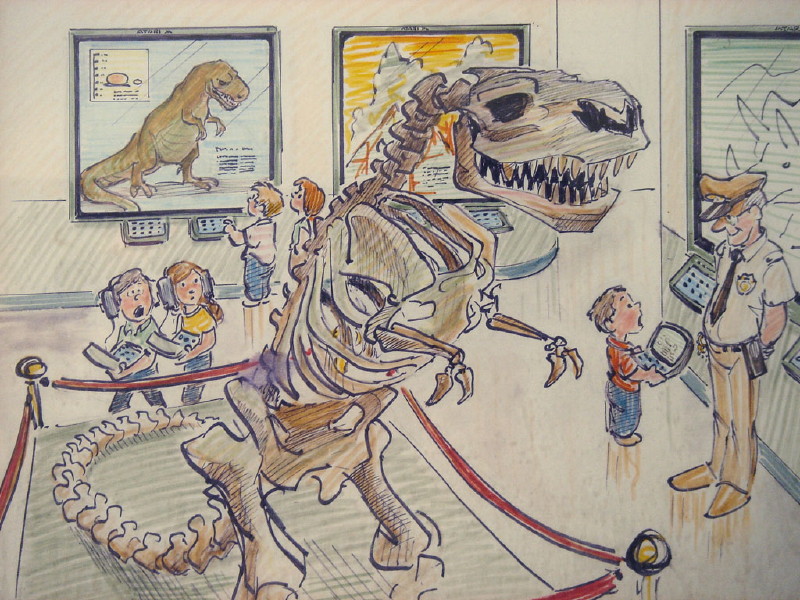
A father reminisces with his son about ’60’s Rock and Roll, calling up footage from the Beatles appearance on The Ed Sullivan Show from the Intelligent Encyclopedia
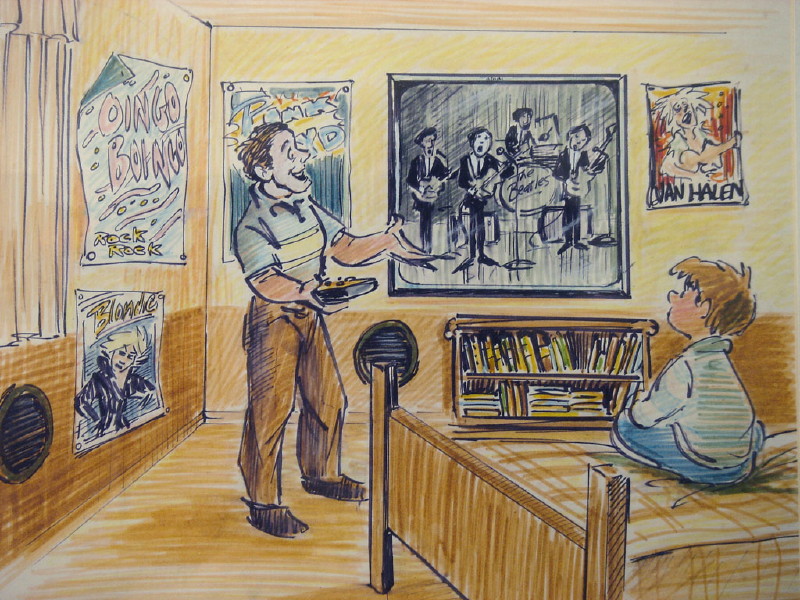
A vintner in northern California wonders what would be involved in changing wine production to sake. On horseback he is asking the Intelligent Encyclopedia about soil and water requirements for growing rice.
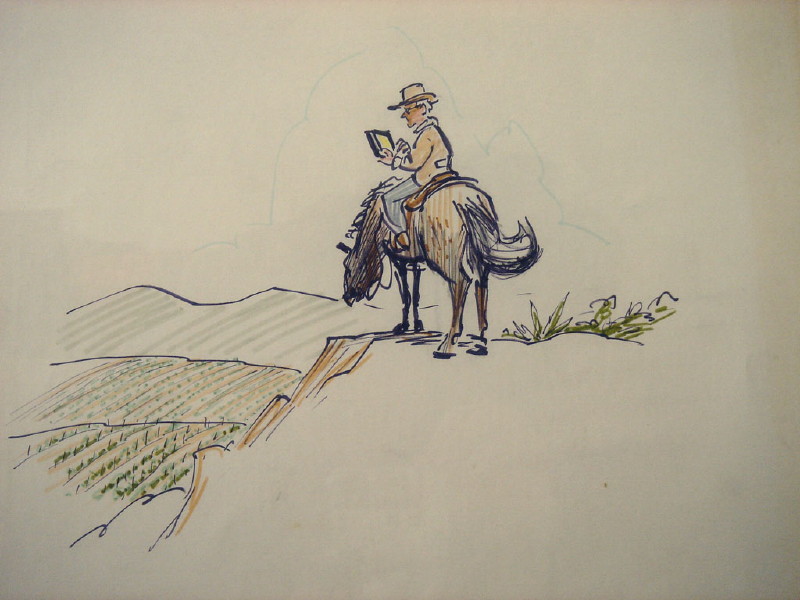
An earthquake wakes a couple in the middle of the night. The Intelligent Encyclopedia, connected to an online service informs them of the severity of the earthquake and makes safety tips readily available.

A third grade class studies various aspects of space travel. The group on the right is running a simulation of a Mars landing while the students on the left are studying a design for a spacecraft.
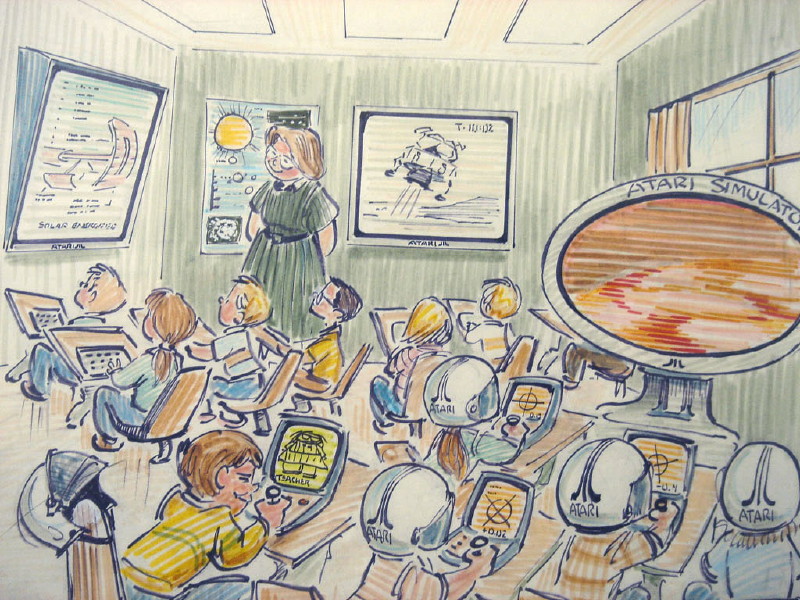
A business man on his way to New York, reviews stockmarket trends.
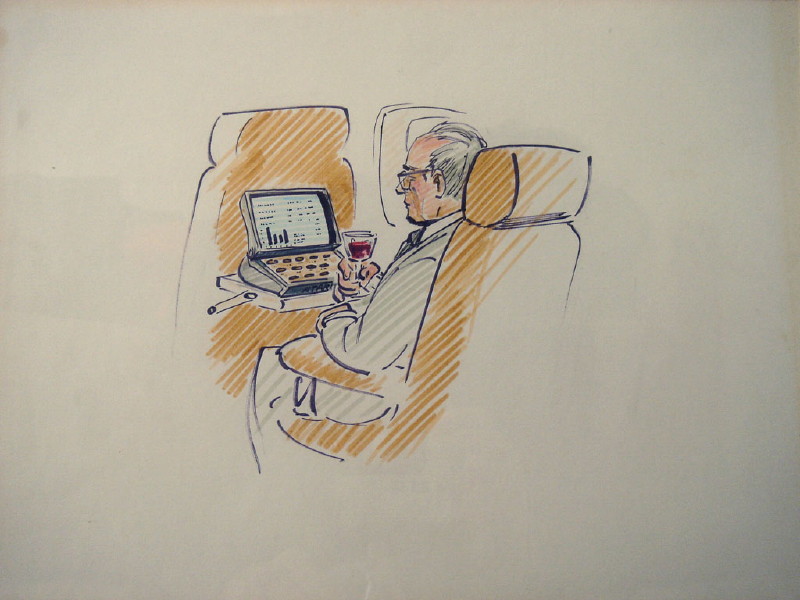
In a bar, the two men at the right are watching football on the screen and running what-if simulations on the countertop Intelligent Encyclopedia which second guess the quarterback. The couple on the left is taking an on-the-spot course in wine connoisseurship.
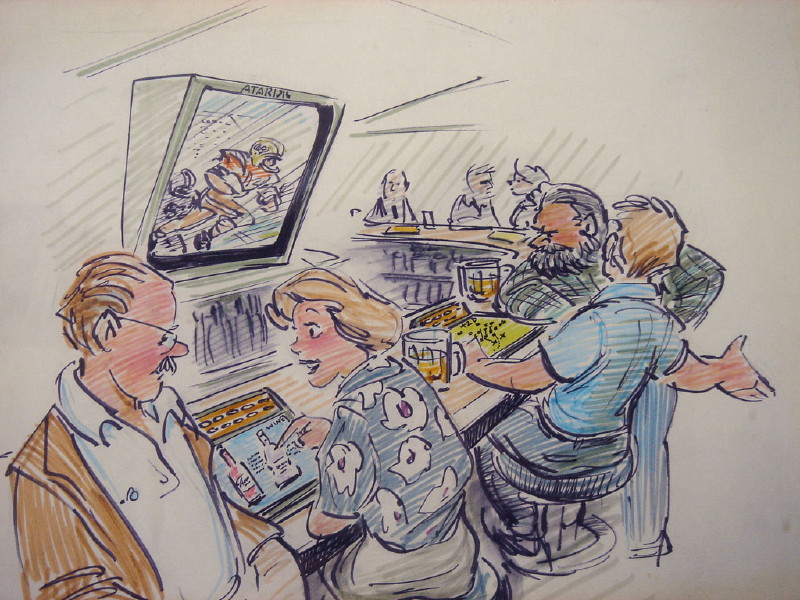
An architect in New York studies Japanese motif for a project he’s working on, while a teacher in Toyo talks with her class about western architectural styles.
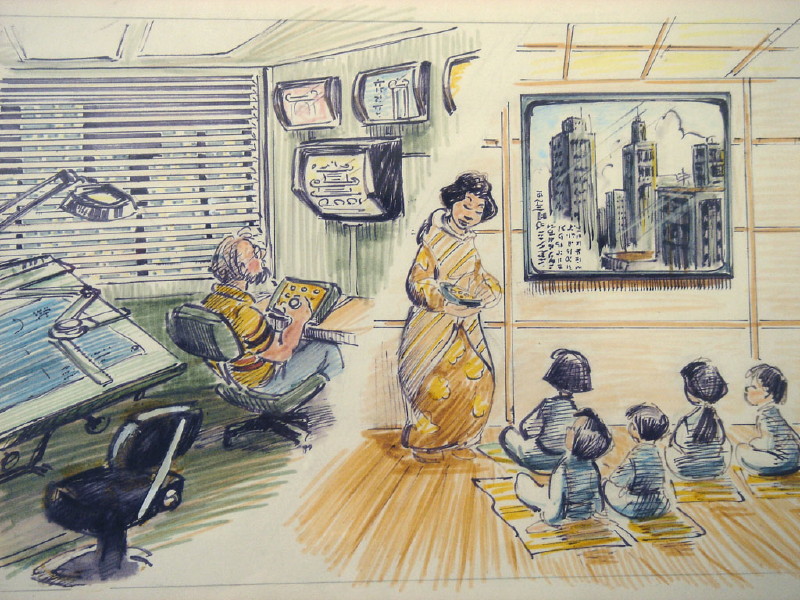
A mother and her children looking into a tidepool in Laguna ask the Intelligent Encyclopedia about the plants and animals that they see. [Notice the antenna for cellular communication.]
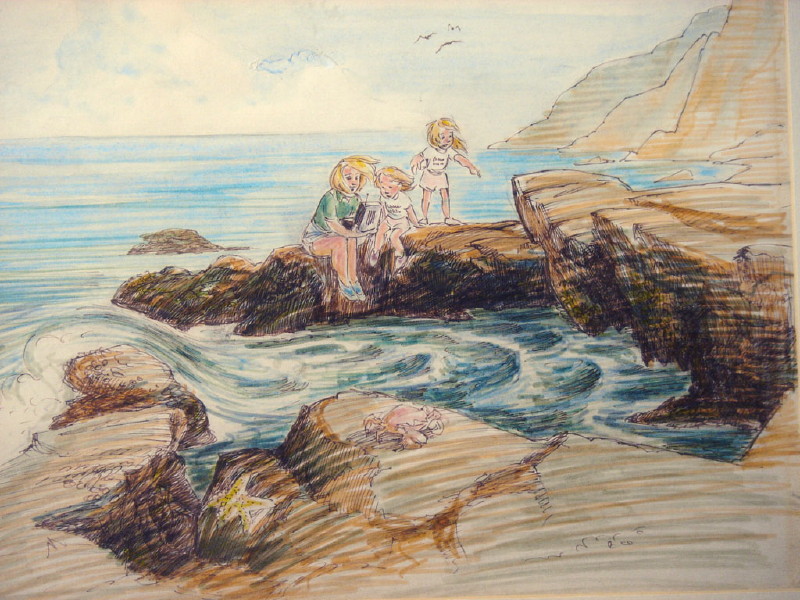
Mobility Shifts Conference at The New School
I think this is going to be a terrific conference.
MobilityShifts: An International Future of Learning Summit
The New School in NYC
October 10-16, 2011
The New School presents the second event in its Politics of Digital
Culture conference series “MobilityShifts: An International Future of
Learning Summit.” Comprised of a conference, hands-on workshops, project
demonstrations, exhibitions and a theater performance featuring youth
and educators from New York City and Chicago, MobilityShifts is a
week-long summit in October 2011. MobilityShifts makes unexpected
international connections between the theories of Jacques Rancière and
Ivan Illich, learning projects outside the bounds of schools and
universities, mobile platforms, and the Open Web. Stop, reflect, listen,
discuss, and build with artists, media scholars, policy makers,
students, technologists, teachers, librarians, legal scholars and
learning activists from 21 countries.
http://mobilityshifts.org/conference/program/
REGISTRATION
To attend MobilityShifts you must register.
The early bird rate ends on September 15th.
http://www.mobilityshifts.org/register1
Participants include: Eduardo Ochoa, Hal Plotkin, Cathy Davidson,
Michael Wesch, Oliver Grau, Mimi Ito, Henry Jenkins, Anya Kamenetz,
Geert Lovink, Shin Mizukoshi, John Palfrey, Irit Rogoff, Juliana Rotich,
Benjamin Bratton, Katie Salen, Shveta Sarda, Molly Steenson, Elizabeth
Losh, Tony Conrad, Lev Manovich, Torsten Meyer, Jan Schmidt, Tomi
Ahonen, Beth Coleman, John Willinsky, Siva Vaidhyanathan, Alexander
Halavais, Giselle Beiguelman, David Carroll, Tania Bustos, Kate
Crawford, Chris Csikszentmihalyi, Sean Dockray, Rolf Hapel, Juan Manuel
Lopez Garduno, Daria Ng, Chris Lawrence, Josie Fraser, David Theo
Goldberg, Marisa Jahn, Sam Gregory, Shravan Goli, Manu Kapur, Edward
Keller, Eric Kluitenberg, Jairo Moreno, Michael Pettinger, Michael
Preston, Daniela Rosner, Richard Scullin, Ramon Sanguesa, Elaine Savory,
Luis Camnitzer, Nishant Shah, Janek Sowa, Dan Visel, Nitin Sawhney and
many others.
Summit Chair
Trebor Scholz
Co-Chairs: Edward Keller, Elizabeth Losh, Matthew K. Gold, David Theo
Goldberg , Karen DeMoss, Sean Dockray
Producer: Jennifer Conley Darling
Associate Producers: Caroline Buck, Liz Carlson
Selected workshops: http://mobilityshifts.org/workshops/
(Workshops require an additional reservation at no extra cost).
This summit builds on two previous events: Mozilla’s Drumbeat Festival
in Barcelona (2010) and Digital Media and Learning in Los Angeles
(2011). MobilityShifts is sponsored by The John D. & Catherine T.
MacArthur Foundation, The New School and the Mozilla Foundation. We
gratefully acknowledge our partners: American University of Paris,
Carnegie Mellon University, Eyebeam Art & Technology Center,
Goethe-Institut, HASTAC, Japan Society, MetaMute, Prezi, School of the
Art Institute of Chicago, SocialText, UC San Diego’s Sixth College, and
University of Pennsylvania.
